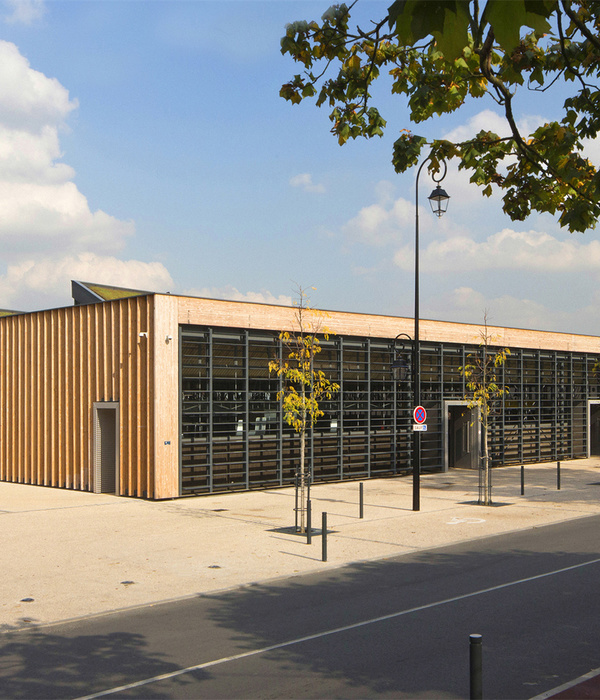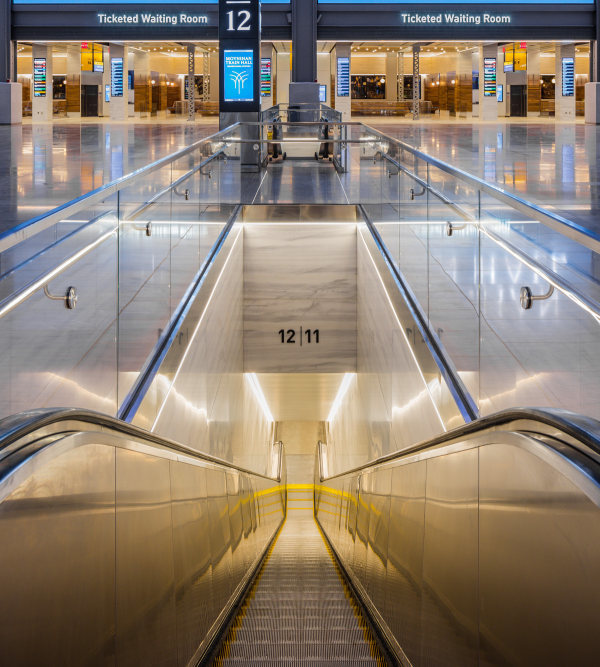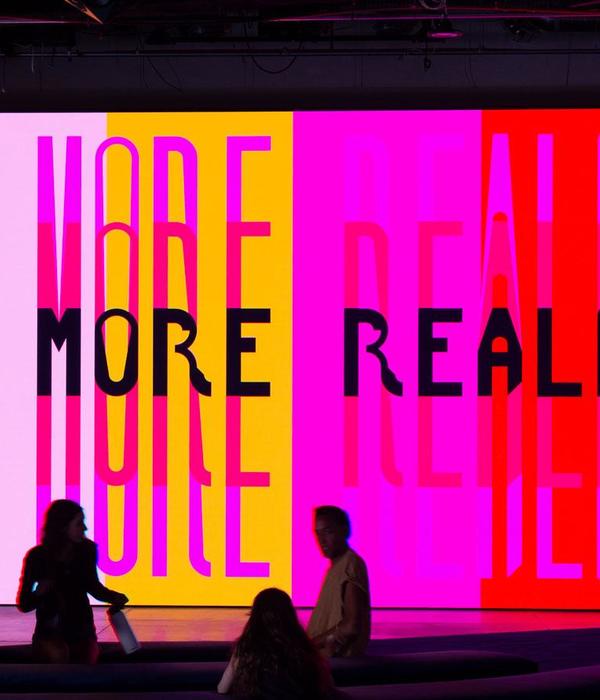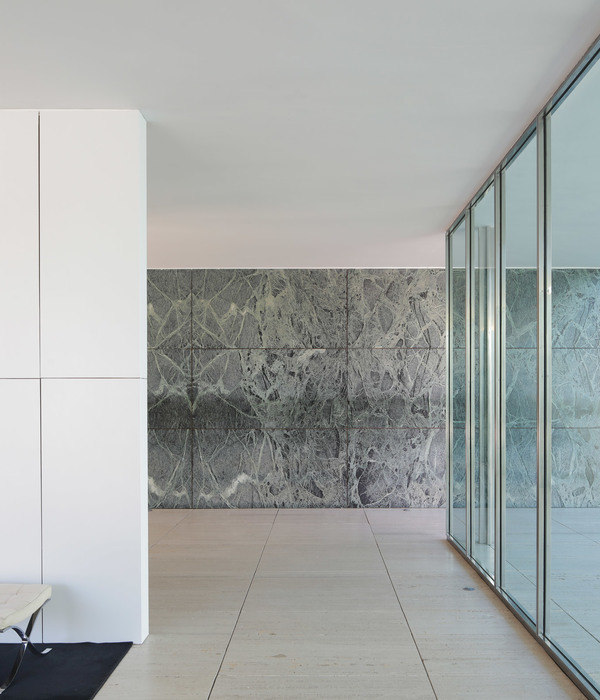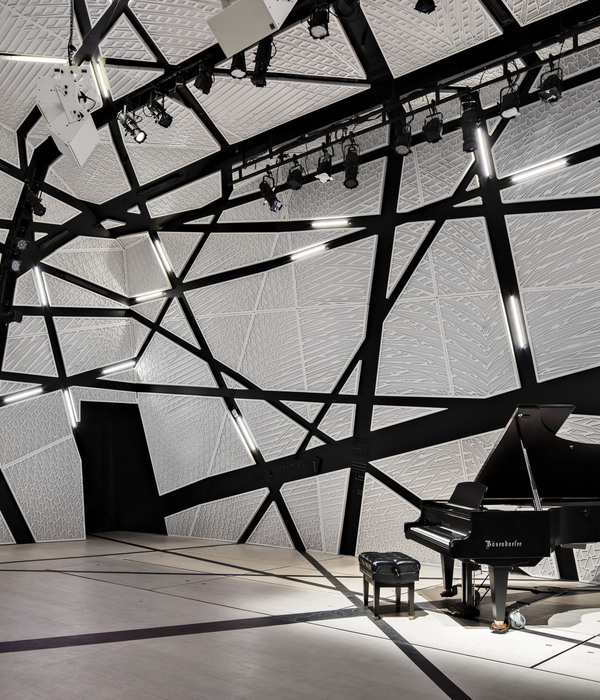整体概念与目标
Overall Concept and Goal
基地长近一公里,宽度介于10米至15米之间,前身为真如货运铁路支线,后改为曹杨铁路农贸综合市场,2019年市场关停后这个空间在不到一年的时间被重新规划建设为一个全新的、多层级、复合型步行体验式社区公园绿地。
曹杨百禧公园以“3K”通廊为概念将艺术融入曹杨社区生活,以从多维度回应2021年上海城市空间艺术季。设计通过挖掘场地文脉、建构空间场景,得以重塑街道绿网、形成“长藤结瓜”般的南北贯穿的步行纽带,进一步拓展曹杨社区的有机更新。
Once carrying the branch line of Zhenru freight rail and later Caoyang Farmers’ Market, the near to 1-kilometer-long and 10- to 15-meter-wide site has been re-programmed as a fresh, multilevel and mixed-use park, walkable and community-centered, shortly after the market’s closure in 2019.
Conceived as ‘3K Corridors’, Caoyang Centennial Park brings art to community life, echoing the theme of 2021 Shanghai SUSAS. Site contexts were discovered and scenes reimagined, so as to design a vine-and-melon-like walking belt, from north to south, to reshape the streets’ grassland system, giving a further step of organic renewal of Caoyang Community.
▼七夕廊桥鸟瞰,aerial view of the love bridge ©朱润资
作为曾经的铁路用地和随后20多年农贸市场,这个特殊的线性空间属于超大城市里的典型剩余空间。当看到场地的一刹那,我们意识到在熟悉的城市中,仍有出乎意料的、蕴藏着惊喜的边角料空间,而如何再利用这类空间是城市化进程进入存量时代的必经思考。
The special linear site, having served as a railway-land and then a market for over 20 years, is a typical left-over space in megacities. We realize at first sight that even in a familiar city are there unexpected and surprising offcut spaces, and we must consider how to recycle them in the time of urban redevelopment.
▼兰溪路跨街天桥,Lanxi road overpass ©朱润资
▼中段过街天桥望向环球港双子塔,view towards the Star Global Port Tower on the overpass bridge ©朱润资
背景与机缘 Background and Opportunity
作为新中国成立后的第一个规划建设的工人新村,基地所处的曹杨新村代表了一个时代的集体记忆和历史进程。市场沿废弃铁路南北贯穿于紧邻的工人社区,区政府及其街道办为提升区域生活水平与空间品质,将该地目标定义为未来提供居民日常文化休闲活动的城市公园。
项目伊始仅以两天完成首版方案,以不足两周时间调整、敲定方案。此后设计调整与深化协同施工开挖等工作在各个部门协调下同步推进,基础分段完工后预制钢构逐步进场,在不到一年的时间周期中从概念方案设计到最终落成投入使用。
Caoyang Xincun, the earliest planned workers’ community by the PRC’s government, bears special collective memories and historical processes of that age. Close to workers’ residences were market houses built along the abandoned railway in the site. To improve the standard of living and spatial quality of Caoyang, the district government and its sub-district office adjusted the place to a city park for future leisure, cultural, and daily events.
The project was on a tight schedule: 2 days to sketch a design and 2 weeks to improve and firm it up. After that, under the coordination of several departments, all works were carried out smoothly. Design followed by drawings, and concreting by steel-framing. Within 1 year, the idea of the park is becoming a reality and put in use.
▼设计草图,design sketch ©刘宇扬建筑事务所
设计策略与场景
狭窄的场地通过立体的设计手段被赋予3倍的空间延展,成为附近住宅区、学校、商业办公等不同使用人群在不同时段下休闲活动的边界拓展。
由于地铁以及周边楼距限制,半地下层的开挖限度被控制在1米;首层向上抬高1.4米,预留出部分底层空间作为社区“收纳器”提供如艺术展览、社区活动、文创集市等临时性功能;另一方面,为了不造成公共空间对周边小区居民楼的干扰,南北贯通的高线步道被限定在离地3.8米的高度。
Through a multilevel strategy, the narrow site expands itself threefold for different use by different people in nearby residences, schools, and offices. With limitation on distances to underground tunnel basis and building of surroundings, it is excavated just 1 meter deep for a semi-basement. The first level is raised to 1.4 meters to spare more space for the semi-basement as a social ‘container’ for temporary programmes like artist exhibition, community activities, creative markets, etc. Besides, the highline way is limited to 3.8 meters high to avoid that the public space possibly disturbs surrounding residential houses.
▼项目区位,project location ©刘宇扬建筑事务所
▼景观节点与周边环境分析,analysis of the landscape joints and the surrounding environment ©刘宇扬建筑事务所
全长880米的景观长廊划分为南北两翼,聚合10组场景以满足聚集、活动、娱乐、休闲、运动等公共服务。
立体长廊从核心向南北延展,串联社区活力,形成互不干扰又交错对话的多维立体空间。
北端入口作为面向曹杨的城市客厅,将左右两侧的联农大厦、中桥大楼裙房纳入设计更新范围,使之围合地面与云桥形成高低两层的入口广场,可行进、可远眺。
中段跨越城市道路的双流线过街天桥整合了兰溪路两侧公园的步行体验,使得街道上的生活、熙熙攘攘的车流与行人共同组成了公园场景的一部分。
而南端以环形廊桥连接了左右的直线云桥,前后各有一颗朴树穿过云桥空隙,随着生长茎叶相互缠绕,行经其中可碰触枝叶。
我们希望尽可能地增加一些绿化,见缝插针地去种一些树,一些草,一些花,让这个整个空间除了钢铁, 也有绿意。
▼景观长廊上设置十组不同场景,ten scenarios in the park ©刘宇扬建筑事务所
In the 880-meter-long park, divided into north and south part, 10 scenarios are conceived to serve public functions such as gathering, activity, entertainment, leisure, sports, etc.
Spreading from middle to the north and south ends, the corridor connects social energy and forms multilevel spaces in separation from yet with dialogue to each other.
The north gate is a main entrance. With nearby Lianong Building’s and Zhongqiao Tower’s façade design integrated, the ground floor level and the highline define together the entrance, facing to Caoyang, as a city hall, where visitors can stroll and overlook.
In the middle passes a double-line highway over Lanxi Road, integrating the park’s walking experience on both sides. Life on streets with walking residents and running cars all together then consists part of scenes in the park.
A circular corridor connects two ways of the highline in the south section, with two hackberry trees standing through voids among the structure. With branches stretching and leaves tangling, visitor can touch the green while walking on the highline.
We hope as much green as possible in the park. Planting some trees, some grass and some flowers makes it an ivy of steel.
▼部分节点生成分析,generation analysis ©刘宇扬建筑事务所
ALYA的三个比较重要的线型的公共空间——吴淞江边上的爱特公园、浦东民生码头贯通、杨浦滨江贯通,后两个也分别是2017年和2019年上海城市空间艺术季SUSAS的展场。 曹杨百禧公园的设计总结了我们过往几个项目的经验, 但它有别于一江一河的独特场景,它所处的环境恰恰是一个如此有烟火气,又如此容易被忽略的的典型社区场地中的非典型剩余空间。 如何能够在这些剩余空间中找到新的潜力与能量,是我们下阶段工作与研究的重要启示。
Three important linear public spaces designed by ALYA: Aite Riverfront Park along Suzhou Creek, Pudong Minsheng pier connection project and Yangpu riverside connection project along Huangpu River. The latter two served separately as 2017 and 2019 Shanghai SUSAS exhibition sites.
We summed up experience of these projects in the design of Caoyang Centennial Park, which, however, differs from riverside spaces. It is located in such a typical context, a worldly community, while playing an untypical role likely to be neglected.
The project is an important revelation for us to study and work out in the next step how to creatively exploit potentials and harness energies in these left-over spaces.
▼北段曹杨路入口鸟瞰,aerial view of the north entrance at Caoyang road ©朱润资
▼北段曹杨路入口,view of the north entrance at Caoyang road ©朱润资
色彩选择
Colour Match
我们花费了很长时间选择颜色,并非一开始就想清楚的。主基调上当然希望是一个比较温和、不突兀的颜色,但如果只是灰色或银色,则表达不出社区的活力。
我们打样了十种颜色配比方案。最终选择了在云桥钢结构主体为银色的基调下,内侧喷涂橙色,希望通过颜色的对撞展现朝气。
We took a long time in colour matching, with no clear idea at the beginning. We hoped it would be mild and fitting on the whole, while worrying that mere silver or grey colour cannot convey the energy of communities. We tried more than 10 schemes of colour combination and finally decided to keep the main structure silver-grey and paint the inner sides orange, in the hope that the colour comparison would express a sense of vigour.
▼北段兰溪路端小广场与艺术墙,银色钢结构内侧喷涂橙色 north plaza and the art wall, inner sides are painted in orange color ©朱润资
1.4米标高以下的空间则有不同考虑。半地下空间的客观条件是狭窄、暗淡的,如何让暗的空间与地面之上亮的空间相协调?我们选择了与云桥不同的色彩方案:半地下室顶板的钢构以银白色为主,内侧喷涂黄色。这种银白色是一种珍珠白,银粉比例较大,与地面以上的银灰色不同。我们判断半地下空间体验感的重要性高于颜色的统一性,这可能是大部分建筑师都不会做的决定,也是之前的项目没有遇到过的挑战、突破了一点常规的思维。
▼北段半地下室入口,entrance of north part semi-underground ©朱润资
▼北段底层开敞空间,廊桥内侧喷涂黄色 open space of north semi-underground,the inner sides are painted in yellow color ©朱润资
▼北段半地下空间,north part semi-underground space ©朱润资
▼北段地下展廊,semi-underground gallery space of north ©朱润资
We considered specially for the space under 1.4 meters high. The semi-basement, differing from light and open ground floor space, is dark and narrow. We chose the combination of silver-white and yellow for the dark to make it harmonize with places above the ground. The silver-white colour is somehow like pearl, mixed with much metal powder, looking apparently different from the silver-grey colour painted on the structures above. We weighed the experience in the semi-basement over the unitarity of colours, a decision unlikely to be made by most architects. This challenge is unprecedented for us and demands some breakthroughs.
▼廊桥与南段地下室入口,bridge and the south semi-underground entrance ©朱润资
▼不同标高分层空间
space with different height level ©朱润资
▼南段半地下室入口空间
entrance space of the south semi-underground ©朱润资
▼南段底层开敞空间,open space of the south part semi-underground ©朱润资
▼南段半地下室入口及宝特瓶,south semi-underground entrance and the BOTTLE space ©朱润资
▼南段宝特瓶下植物生态装置,plant installation under the South BOTTLE space ©朱润资
▼南段桥下景观空间,landscape space under the bridge of South part ©朱润资
拱棚——铁路月台的记忆
设计上有意识地在公园里创造了一系列连续的轻质拱棚架构,覆以遮阳膜。遮阳而非遮雨出于两点考虑:一是在线性的开放公园内重要的是感受自然;二是技术层面的考虑,一旦选用遮雨的膜,就需要承受更多风荷载,无法在建造层面上凸显云桥与拱棚的轻与重的张力对比。
We consciously designed a series of lightly structured arc canopies, membraned for sunshade. The membrane is not waterproof out of two considerations: first, we encourage to feel the nature in such a linear open park; second, technically, the canopy would bear more wind load if membraned waterproof, making the structural comparison invalid of lightness of canopies and heaviness of the highline.
▼轻质拱棚结构,lightly structured arc canopies ©朱润资
▼从小广场看向拱棚,view to the canopy from the outdoor stage ©朱润资
拱棚形式上的意义是勾起我们这种对铁路的记忆——曾经绿皮火车徐徐入月台的场景。 月台有很多种形式,我们就选择一个最简单的拱形做不同的串联,也选择了五种不同颜色。 因为样式是重复的、颜色是变化的,于是拱棚有了给整个公园分区的意义——在端头是一个蓝色,再往前有一个粉色——通过颜色可以简单地定位人的位置。
Arc canopies are reminiscent of railway platforms by which traditional trains slowly pulled in. There were many forms for railway platforms, and we chose one of the simplest and colouring it in five different ways. With the same form but changing colours, the light structures afford a clear zoning for the park. Blue here and pink ahead, visitors can easily locate themselves through these arc canopies.
▼拱棚下的桥上空间,walkway under the canopy ©朱润资
▼沙田月台下活动空间_Activity space under the Shatian Platform ©朱润资
作为边界与连接的围墙——与社区和公共机构对话
我们的设计团队同街道办一起与每一个社区都有认真地对话、探讨、磋商。百禧公园周边共有十一个居民社区,还有若干个公共机构。建设公园与社区或机构的边界其实需要多方的对话,通过沟通得知对方的需求、彼此的困难与界限,最终形成良好的连接。
Our design team, together with the sub-district office, have had earnest dialogues with each residence nearby. 11 residences and several public institutions surround Centennial Park. Setting boundary between the formers and the latter actually needed communications, through which we got to know their requirements and problems, thus able to connect in a better and more suitable way.
▼七夕廊桥与老墙,love bridge and the old wall ©朱润资
▼七夕廊桥结构,可以看到后方的艺术墙体
Love bridge structure with view to the art wall behind ©朱润资
在百禧公园围墙方案的设计过程中,我们产生了不下十种墙与门的组合类型。其中有水洗石饰面的实墙,有在不同程度上允许视线交流的钢构围墙,也有两者的结合。我们希望以不同类型的墙与门来尊重社区的意愿,通过与居民讨论、协商共同设计公园与社区的连接与边界。
有的社区选择实墙、选择不开门,另一些选择通透的钢构围墙,希望公园的绿色也能渗透到社区里来。所以顺着百禧公园一路走过去能观察到围墙的变化。
▼钢铁廊桥与绿植墙,steel bridge and green plant facade ©朱润资
▼施工过程,construction process ©朱润资
▼节点模型,models of the joints ©刘宇扬建筑事务所
▼平面图,plans ©刘宇扬建筑事务所
▼剖面图,sections ©刘宇扬建筑事务所
▼细部,details ©刘宇扬建筑事务所
项目名称:曹杨百禧公园 项目地点:上海市普陀区曹杨新村街道曹杨路875号 项目类型:市政景观
基地面积:10165 平方米 建筑面积:2892 平方米 设计时间:2020.10-2021.08 建设时间:2021.01-2021.09
设计单位:刘宇扬建筑事务所 概念阶段:刘宇扬、梁俊杰、刘泽弘、吴祺琳(实习生) 深化阶段:刘宇扬、吴从宝、刘泽弘、徐嘉瑞、赵明明、刘玉、王茵、钱铮、孙宇昂(实习生)、侯睿菲(实习生) 施工配合:刘宇扬、吴从宝、刘泽弘 项目管理:吴从宝、刘泽弘 设计范围:总体规划、建筑设计、灯光设计、标识设计
景观设计:上海市园林设计研究总院有限公司 导视设计:萬邦智合|聿凡数字科技(上海)有限公司 结构及机电设计:华东建筑设计研究院有限公司 施工总包:中国中铁市政环境建设有限公司 建设单位:上海市普陀区人民政府曹杨新村街道办事处
结构类型:钢结构 主要建筑材料:EPDM塑胶地面、不锈钢条筛板、玻璃钢格栅+双层玻璃(可上人天窗)、镀锌钢格栅、不锈钢绳网、丝印玻璃、氟碳漆喷涂钢板 主要室内材料:环氧树脂地坪、GRC挂板 主要景观材料:花岗岩、水洗石
摄影:朱润资,梁俊豪 撰文:刘宇扬, 梁俊杰
Project Name: Putuo Caoyang Centennial Park Location: 875 Caoyang Road, Caoyang Xincun Sub-district, Putuo District, Shanghai Type: Landscape Infrastructure
Site Area: 10165 sqm Building Area: 2892 sqm Design Stage: 2020.10-2021.08 Construction Stage: 2021.01-2021.09
Design Team: Atelier Liu Yuyang Architects Concept Design: Liu Yuyang, Leung Edward, Liu Zehong, Wu Qilin (Intern) Developed Design: Liu Yuyang, Wu Congbao, Liu Zehong, Xu Jiarui, Zhao Mingming, Liu Yu, Wang Yin, Qian Zheng, Sun Yuang (Intern), Hou Ruifei (Intern) Site Supervision: Liu Yuyang, Wu Congbao, Liu Zehong Project Management: Wu Congbao, Liu Zehong Design Content: Overall Plan, Architecture, Lighting, Signage
Landscape: Shanghai Landscape-Architecture Design and Research Institute Co., Ltd. Signage: Vanguard Design Studio Structure & MEP: East China Architectural Design & Research Institute Co., Ltd. Contractor: Municipal Environmental Construction Co., Ltd. Of CREC Client: Caoyang Xincun Sub-district Office of Putuo District Municipal Government
Structural Type: Steel Structure Main Architectural Material: EPDM rubber floor, stainless steel sifting plate, glass-fibre reinforced plastic grille plate + double-glazed glass (accessible sunroof floor), galvanized steel grille plate, stainless steel wire rope net, silk-screen printing glass, fluorocarbon-coated steel plate Main Interior Material: phenolic resin epoxy floor, GRC panel Main Landscape Material: granite, washed stone
Photography: Zhu Runzi, Liang Junhao Text: Liu Yuyang, Leung Edward
{{item.text_origin}}





